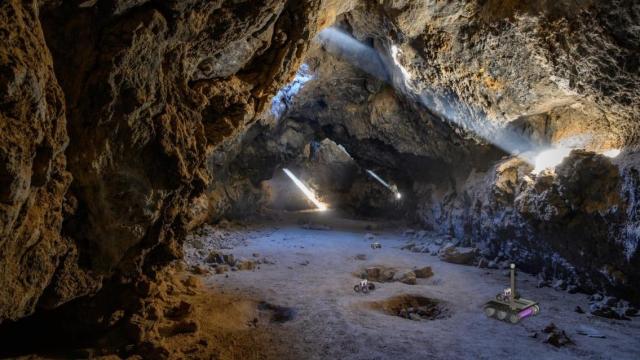Researchers from the University of Arizona have developed a possible new way of scouting for real estate on other planets: tiny robots that drop digital breadcrumbs while exploring Martian caves. It’s a method ripped straight from folklore.
The breadcrumbs are actually small sensors that the rover will carry along with it. As the rover moves through an unexplored cave system, it will drop a sensor, continue to move through the system, then drop another sensor when the signal from the previous sensor begins to fade. Drop a sensor, explore the cave, repeat. This work serves to map the cave system, with the sensors sending their subterranean information back to a mother rover waiting on the surface. The technology is detailed in a paper published last month in Advances in Space Research.
“One of the new aspects is what we call opportunistic deployment — the idea that you deploy the ‘breadcrumbs’ when you have to and not according to a previously planned schedule,” lead author Wolfgang Fink said in a University of Arizona press release. Fink is a professor of electrical and computer engineering at the University of Arizona.
The breadcrumbs will serve as nodes in a giant network that will offer insights into the layouts of different cave systems. This network will allow the nodes to transmit data back to the mother rover on the surface of the planet by sending data to and through each node in the network, which will create a robust signal and prevent gaps in the network if a node fails. This also means that there’s no need to retrieve the rovers from the caves at the end of their mission, since the data is transmitted wirelessly, which will save time and resources.

“They can switch between each other and compensate for dead spots and signal blackouts,” said co-author Mark Tarbell, a research scientists at the University of Arizona, in the press release. “If some of [the nodes] die, there still is connectivity through the remaining nodes, so the mother rover never loses connection to the farthest node in the network.”
The desire to explore cave systems is one borne out of a creative approach to long term habitation. Scientists recently found that pits on the Moon maintain comfortable temperatures, which could make them an ideal campsite for future crewed missions to the lunar surface. Similarly, planets like Mars can offer vast systems of caves that could be used for astronaut habitation since they offer protection from harsh weather on the surface and cosmic radiation penetrating the planet’s thin atmosphere.
“Lava tubes and caves would make perfect habitats for astronauts because you don’t have to build a structure; you are shielded from harmful cosmic radiation, so all you need to do is make it pretty and cosy,” said Fink in the press release.
Fink and his colleagues also suggest that this methodology could be applied to planets with vast oceans or lakes — submersibles could relay exploration data to a lander floating on the surface via a long cable, with the nodes boosting the signal along the way. The network and rovers could also be used to aid in search and rescue efforts on Earth after a natural disaster strikes an area, like the 2023 Turkiye earthquake.
All this to say that Fink and his colleagues’ work is still theoretical. The team has built the rovers and the technology to allow them to communicate with each other, but the next step is to actually build the mechanism that will drop the breadcrumbs.
More: Experiments With Barbie Dolls Reveal a Surprising Way to Keep Spacesuits Clean on the Moon
